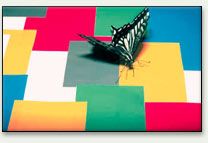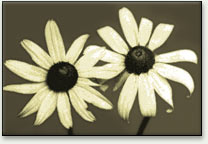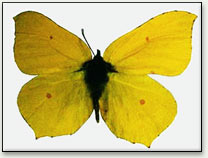A page from the "Causes of Color" exhibit...
What colors do butterflies see?


A butterfly can be trained to land on a yellow portion of the colored grid. Moreover, butterflies have color constancy (like humans) and will still recognize yellow even if the illuminating light changes considerably.
Great chefs know that enjoying a meal involves more than taste, and they go to great lengths to give food visual appeal. Likewise, flowering plants use unique visual cues to attract butterflies for a tasty meal that will also help with pollination.
The symbiotic relationship between flowers and butterflies has evolved so that flowers encourage butterflies and other pollinators to feed on their nectar. Plants attract potential pollinators in many ways, including by their color, scent, reflectance, size, outline, surface texture, temperature, and motion. In contrast, plants that do not depend on insect or bird pollination are unlikely to have showy or scented flowers.
To attract the potential pollinator to a particular blossom, the availability of nectar has to be advertised. These nectar guides, which are also known as "pollen guides" or "honey guides," present a visual contrast, either in form or coloring. Sometimes we can see these patterns, and sometimes they are in the ultraviolet range.
Butterflies respond to the color of the petals. The color of the nectar guide of the horse chestnut tree (Aesculus hippocastanum) changes from yellow to red when nectar is no longer in production.
One flower that shows a bulls-eye effect in the ultraviolet range is the black-eyed Susan (Rudbeckia hirta), which contains compounds that absorb light strongly between wavelengths of 340 nm and 380 nm. The petals of the black-eyed Susan, a large daisy-like flower, appear plain yellow to humans, but insects see a very dark center.
Butterflies vary widely in their sensitivity to light, and are considered to have the widest visual range of any form of wildlife. The Chinese yellow swallowtail butterfly (Papilio xuthus) has a pentachromatic visual system (i.e., the eyes contain five different types of cells, which each react to a different band of light). It uses color vision when searching for food, and is sensitive to UV, violet, blue, green, and red wavelength peaks, suggesting color constancy. In nature, these butterflies feed on nectar provided by flowers of various colors not only in direct sunlight, but also in shaded places and on cloudy days.
The windmill butterfly (Atrophaneura alcinous) has a visual range from at least 400 nm to 700 nm, while the Sara Longwing butterfly (Heliconius sara) has a range from 310nm to 650nm.

|

|
|
|
Invisible patterns are revealed on this black-eyed Susan and Cleopatra butterfly in ultraviolet light. |
||
To the human eye, many butterflies appear the same, but the butterflies themselves can often identify each other quite easily using ultraviolet markings. Shown above is the yellow Cleopatra butterfly (Gonepteryx cleopatra). The male and female little sulphur butterflies (Eurema lisa) differ only in the ultraviolet region, with the males being strongly ultraviolet reflective and the females non-reflective in ultraviolet. In contrast, butterflies that are palatable to birds display significant differences in appearance.
The ultraviolet patches on some butterflies are directionally iridescent, so that they appear to flicker in flight. This flickering is thought to have an important role in butterfly behavior and communication.
Butterflies tend to avoid the color green when feeding, but are attracted to it during egg laying. The next generation needs to hatch near a good source of food, as caterpillars have a voracious appetite. The green photoreceptors are used for the detection of movement, rather than when foraging.



